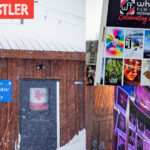In the 1920s an impecunious Ernest Hemingway bummed around the Italian Dolomites, hitching rides on pre-dawn milk trains chugging up to high farms, using them as ski lifts.
Only a decade ago, the tourist director of St. Anton in Austria told me, “We open our arms to ski bums.” And one who took him up on it was my old skiing buddy, author (Wag the Dog) and ski instructor Larry Beinhart.
My move to the Alps in 1983 was similarly eased by an open-armed welcome. Never having been to Switzerland, I came across a piste map of the Verbier ski region by accident: 400 km of trails, a cable car to 3,333 metres and a ski season from the end of October to early May.
I sat down and wrote a letter to the tourist office. Would it be possible for someone on a limited income (I had just quit my job) to spend a winter in Verbier? Back came a photo of an old mayen, a herdsman’s chalet with stables underneath. A woman in the tourist office had taken the trouble to find me a one-bedroom rustic residence at 1,750 metres above the village, with a castiron wood stove, huge stone fireplace, and ski in and out over the fields.
My landlady kept sheep and cattle. She was a founding member of the ski school. One son was a mountain guide, the other a ski racer. I helped her shift hay from my mountain barn down to her winter stables in the village. She helped get me discounts at the sports shop her relations owned.
It’s not like that now. Farmers like her long ago sold off their fields for building plots. Now their grandchildren have no land and cannot afford to build or buy in their own community. The construction crane has replaced the cow as the local icon. Tellingly, the region’s artistic landmark, a statue set at the entry to the valley, is the bare skeleton of a supine cow—the kind of thing you might see littering the sands of Death Valley.
There are many apartments in Verbier from which you have no views of the mountains. But there seems to be no part of town without views of construction cranes.
It used to be the rule that cranes were dismantled for the winter season and all construction work halted, in deference to tourism. No more. And the local government has even rescinded an ordinance that prohibited interior renovation during the peak tourist season. So now you can be awakened at 8:00 a.m. by jackhammers ripping out the fl oor in the holiday flat right over your head, and come home to après ski enlivened by the roar of rip saws.
It’s not uncommon for ski resorts to be a work in progress, though there are charming chocolate-box chalet towns where nothing ever seems to change. Mürren across the valley from Wengen in Switzerland is such an example, as are Obergurgl and Lech in Austria.
But there should be a limit, both in time and space. Verbier used to have a bumper sticker, the usual schmaltz: “Je ♥ Verbier.” Now local wits display the ironic: “Je ♥ chantier.” For those of you who failed French, chantier rhymes with Verbier—and means construction site.
Many resorts are spared from sprawl simply because there’s no more room to build. Zermatt and St. Anton in their narrow and steep valleys with threatening avalanches are examples. Others have master plans, limiting growth to preserve ambience (and to keep property values up by limiting the supply of housing). Whistler’s planning, topping out at 50,000 beds, has been a model to the industry.
But when construction becomes a cancer, it not only wrecks the ambience of mountain tranquility and ruins the local agrarian economy, it also kills off the skiing population.
In Verbier, for example, the lift company Televerbier was for decades the prime employer and engine of the local economy. For the past several years, however, new construction and renovation in the resort has grossed over $300 million per year. That’s 10 times the revenue of the lift company.
The effects of this rampant construction on the skiing population are considerable. Twenty years ago, people bought property in the resort because they were skiers. I didn’t know anybody, including weekenders from Geneva who owned second homes, who didn’t buy a season pass.
But when properties go on the market at $30 million, with the smallest chalet at least $2 million and a four-bedroom apartment at $3 million, the purchasers tend to be far less interested in couloirs than they are in collateral and investment potential. They are not buying second homes with a view to integrating into the local ski and mountaineering esprit. They are buying fourth and fifth homes that will most likely remain empty most of the time.
I haven’t heard of any examples of this gentrifi cation or geriatrifi cation phenomenon in North America, though I could imagine Whistler as a candidate some 30 years or more from now. But in the Alps resorts like Gstaad, Crans-Montana and St. Moritz all show signs.
Aside from the obvious incidences of construction cranes, the main warning signal of encroaching affl uence and enfeebling aging in a resort is the proliferation of art galleries. When you see a ski shop on every corner, you know you’re safe. The opening of an art gallery in a ski resort sends shivers down my spine. Next thing you know they’ll be having a summer classical music festival.



